La Paz is nestled in a valley, once you go up and out of it via its sister city El Alto you land on the level altiplano that sits between the valley and the Cordillera Real stretch of the Andes. The range is visible from Isla del Sol and since my trip to the island I’d caught the trekking bug again.
My first foray into the range was to do the Pico Austria trek, and I was joined by Lucy and her boyfriend Tom for the day hike. We took a tour out from La Paz to the starting point at 4,500 m.a.s.l. and then wound our way up to the peak at 5,300 m.a.s.l. The view from the top was breath-taking (I suppose all puns are intentional if you’re committing them to writing), you look out directly onto the caps of the neighbouring peaks, and down onto the nearby glacier and the altiplano lakes below, which reflect the sky like great mirrors. Pico Austria was a surprisingly comfortable hike given the elevation gain and altitude, and subsequently I began entertaining the idea of undertaking the Huayna Potosi trek.
I’d heard about Huayna Potosi from a couple of my friends during my travels, and it was described as “an achievable 6,000 m plus summit”, which wasn’t exactly appealing. I learnt more when I bumped into my friend Charlie in Lima, whose description of trekking across a mountain ridge in crampons with an ice axe didn’t do much to warm me to the idea any further. But my time and relative comfort hiking at altitude across Peru and Bolivia, plus Charlie’s description fading from my memory over time, meant that the notion became more appealing, and Pico Austria sealed the deal.
Subsequently, the “flow state” wave I was riding meant I organised to summit Huayna Potosi on my 27th birthday. I elected for the three-day itinerary for longer acclimation to altitude and for some mountaineering practice.
On the first day, we collected our gear – warm clothes, snow boots and crampons – and drove up to the 4,700 m.a.s.l. base camp. We dropped our possessions off, donned our gear and headed out onto a small portion of nearby glacier. Walking on ice-free mountain terrain in snow boots is far from fun. Your feet are locked into the boots such that your ankles have no degree of movement, which takes it toll on your calves. We then spent four hours out on the glacier for a mountaineering boot camp, clipping on our crampons and practicing the different ice walking techniques. At the end of the session, we got to try our hands at ice climbing, which is basically rock climbing, but if you had to make your own hand and footholds using ice picks and crampons respectively.
On the second day we made our way from base camp to high camp at 5,300 m.a.s.l This hike up the mountain was far more comfortable than the first day as I could do it in my walking boots. Upon arrival at high camp, we prepared our kit for the next morning and got an early night – 6 PM bedtime with our alarms set for midnight.
The midnight start is so that you can make your way to the 6,088 m.a.s.l. peak for sunrise and finish your descent before the morning light has made the ice field dangerous. We set off into the night, backpacks loaded with snacks and water, head torches and helmets clipped on, ice axes in hand.
The first of many challenges was making our way out onto the ice field, clambering down the rocky mountain path in our snow boots. Once down we attached our crampons and clipped our group together. We would be summiting as three trios, one guide to two trekkers – I was paired up with a very chill guy called Vuk and our guide was Felix. Once our harnesses were all clipped together we set foot on the glacier.
As we start the sky is pitch black, punctuated with a smattering of stars, and the summit of the mountain is obscured by false peaks and the glacier itself. We aren’t the first ones out, and the route up the glacier is outlined by the clusters of headtorches bobbing up the mountain. Aside from the star and the other trekkers, your field of vision is limited by the headtorches strapped to your helmet – a cone of light illuminating the trekkers, the path ahead of you and the ice field either side of it. The night itself is quiet, the only sounds are the trudging crunch of crampons and ice axes gaining traction on the compacted ice. The crunching sound, like moving a bag of gravel, gives a three-beat rhythm to the trek, two parts staccato and one part glissando. The staccato comes from your crampons gouging their way into the path and the glissando is from the handle of your ice axe being buried into the snowbanks – ice sliding over metal until there’s a crunch as the hilt of the axe gains purchase.
In order to summit you have to keep pace. In order to keep pace you have to overcome the terrain and the altitude. It soon became evident that I was caught in a spiral – the terrain sapped my energy, which impeded my ability to do cardio at altitude. Which in turn made navigating the terrain more difficult, and so it went on. It was an ever-increasing struggle, as whilst the gentler slope of the open ice field was easier to navigate, the steeper inclines put a real strain on my body. As I increasingly struggled to keep pace, I knew I wasn’t making it to the summit, and the guides sensed it too, as they moved Vuk to join the other, quicker, groups. It was now just Felix and I continuing our way up the mountain. The rate at which I would stop to catch my breath increased, and I’d take sips from my water bottles, both of which were eighty percent frozen from the outside in. As we made our way further up the mountain, the view either side of us became clearer. To one side the twinkling pools of El Alto and La Paz were visible, and to the other, the meandering peaks and valleys of the Cordillera Real.
Like I said, I knew I wasn’t making it to the summit, but I have no great disappointment over it. Summitting that mountain is an endurance sport yes, but you also come up against some pretty insurmountable barriers due to the altitude. When I’ve run or rowed or gone to the gym, I’ve had a certain knowledge that I am capable of the action I’m attempting, but in order to complete it I have to withstand the pain. Something about Huayna Potosi was different, the pain barrier wasn’t one placed on me by my mentality and immediate strength, but rather one placed on me by the way the increasing altitude was limiting my physicality. The implication being that, for me, this wasn’t the type of exercise I could jump into and achieve, if I wanted to complete something like this I’d have to train for it. Regardless of this fact, I’m happy with how far I made it up the mountain, proud even. Not many people can say that they watched sunrise on a glacier at 5,900 m.a.s.l. for their 27th birthday.
That was the ceiling for mine and Felix’s trek, 5,900 m.a.s.l., we stopped there to watch the light change before heading back down. We looked out onto the Cordillera Real, the tops of the range peaked up through the thin blanket of cloud-like fog that clung to them. As the sun rose the colours weaved their way through the upper end of the visible spectrum, reds and oranges and yellows, with pinks intertwined throughout. The blue of the sky was expansive and pristine, an empty canvas for the day to be drawn onto. Sadly, there’s only so long you can stand still for at that altitude and in that temperature. The cold seeps it’s way into your body, through your clothes, into your extremities and then into the rest of your body. We headed a little way down the mountain to ease the altitude and sat and watched the light continue to change. Once the cold became too much, we weaved our way down the mountain to high camp.
As daylight asserted itself, the full view of the glacier became clear, rendering visible the regions that had fallen outside the cone of light from my headtorch. The frozen waves of the glacier in their pristine white and the crevasses that went from white to blue to black as they bored their way into the glacier. I was grateful I hadn’t seen how close to those crevasses I’d been as we’d made our way up the mountain, but more grateful for having been able to witness them first-hand.
The group all reunited at high camp and we then headed down the mountain towards base camp and La Paz together, congratulating ourselves for all we’d been able to achieve that day and looking forward to hot showers and a good nights sleep.
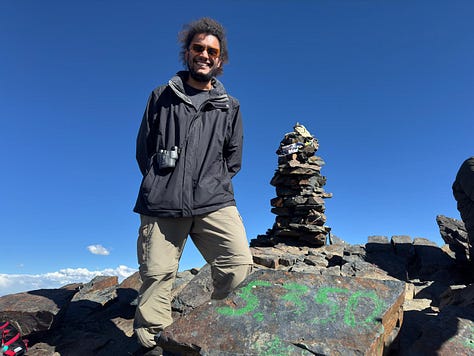
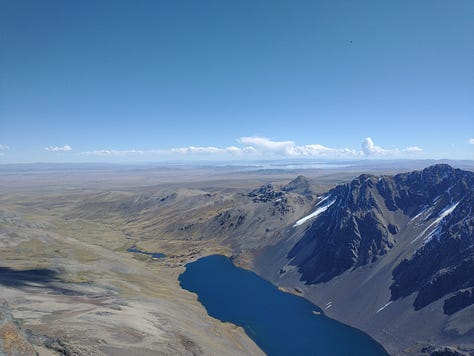
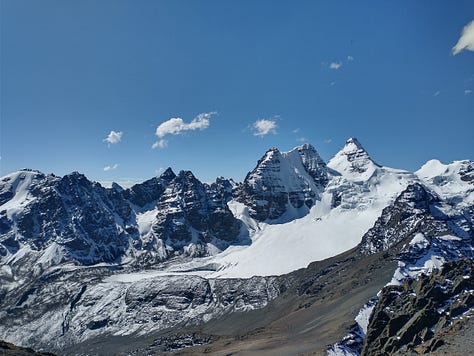
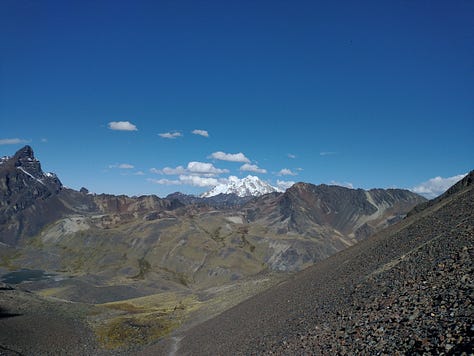
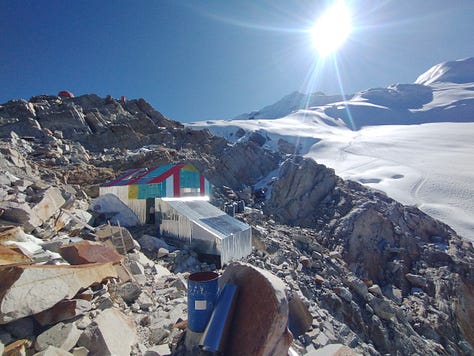
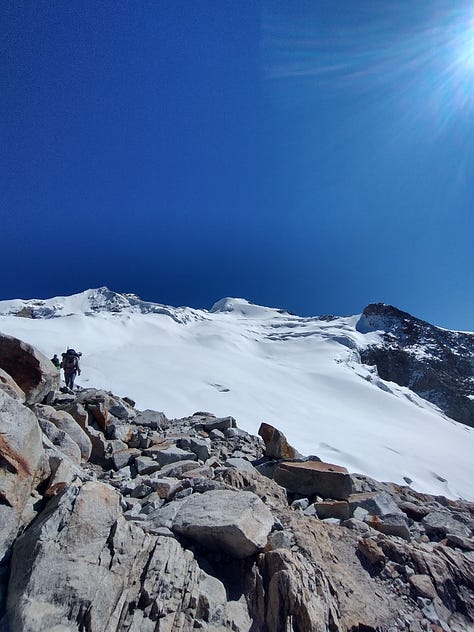
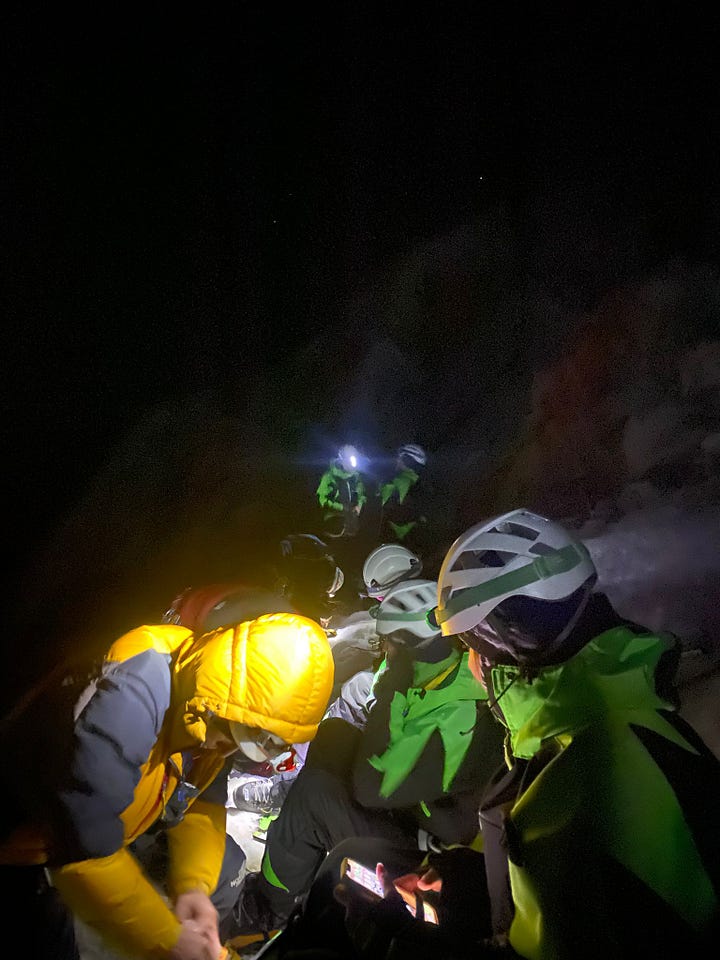
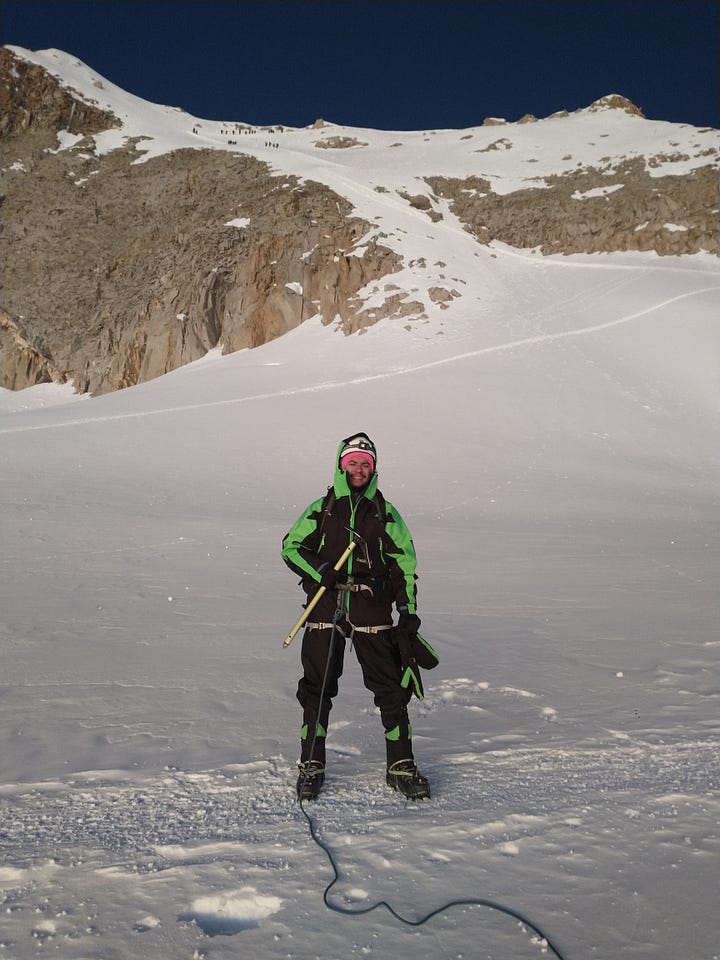
Thanks for reading, if you want to keep up to date, please make sure to subscribe!
In case you missed my previous posts:
Travel Journal 10: Flow State Part 2: La Paz
Travel Journal 9: Flow State Part 1: Isla del Sol
Travel Journal 8: Separating Country from Company
Travel Journal 7: Interlude: Isla del Sol
Travel Journal 6: Echoes
Travel Journal 5: A Sensation of Standing in Some Other System
Travel Journal 4: Glacial Shift
Travel Journal 3: I Get Stuck at the Edge of the World
Travel Journal 2: Finding Your Axes
Travel Journal 1: Beginnings Are Such Delicate Times
Short Story: If You're Listening

